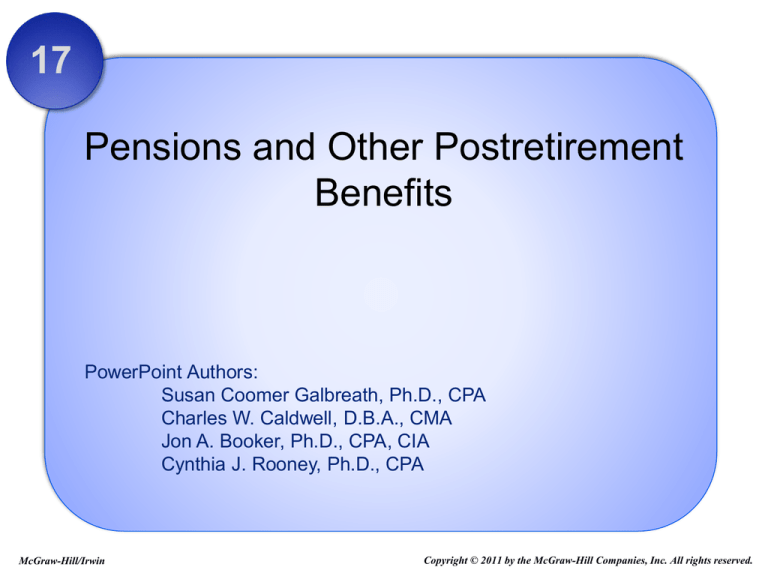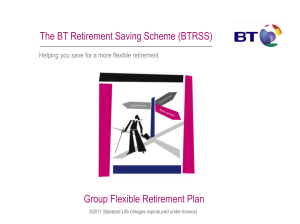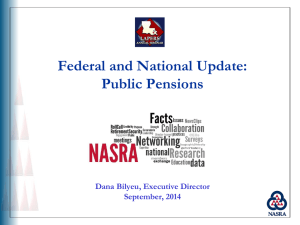
17
Pensions and Other Postretirement
Benefits
PowerPoint Authors:
Susan Coomer Galbreath, Ph.D., CPA
Charles W. Caldwell, D.B.A., CMA
Jon A. Booker, Ph.D., CPA, CIA
Cynthia J. Rooney, Ph.D., CPA
McGraw-Hill/Irwin
Copyright © 2011 by the McGraw-Hill Companies, Inc. All rights reserved.
Nature of Pension Plans
1. Pension plans provide income to
individuals during their retirement
years.
2. This is accomplished by setting aside
funds during an employee’s working
years so that at retirement, the
accumulated funds plus earnings from
investing those funds are available to
replace wages.
17 - 2
Nature of Pension Plans
For a pension plan to qualify for special tax
treatment it must meet the following
requirements:
1. Cover at least 70% of employees.
2. Cannot discriminate in favor of highly
compensated employees.
3. Must be funded in advance of retirement
through an irrevocable trust fund.
4. Benefits must vest after a specified period
of service.
5. Complies with timing and amount of
contributions.
17 - 3
Nature of Pension Plans
17 - 4
Defined Contribution Pension Plans
Plan Characteristics
Contributions
are defined
by
agreement.
17 - 5
Employer
deposits an
agreed-upon
amount into
an employeedirected
investment
fund.
Employee
bears all risk
of pension
fund
performance.
Defined Contribution Pension Plans
Let’s assume that the annual contribution is to
be 3% of an employee’s salary. If an employee
earned $110,000 during the year, the company
would make the following entry:
Pension expense
Cash
3,300
3,300
The employee’s retirement benefits are totally
dependent upon how well investments perform.
17 - 6
Defined Benefit Pension Plans
Plan Characteristics
Employer is
committed to
specified
retirement
benefits.
17 - 7
Retirement
benefits are
based on a
formula that
considers
years of
service,
compensation
level, and age.
Employer
bears all risk
of pension
fund
performance.
Defined Benefit Pension Plan
A pension formula might define annual retirement
benefits as:
1 1/2 % x Years of service x Final year’s salary
By this formula, the annual benefits to an
employee who retires after 30 years of service,
with a final salary of $100,000, would be:
1 1/2 % x 30 years x $100,000 = $45,000
17 - 8
Defined Benefit Pension Plan
An actuary assesses the various uncertainties
(employee turnover, salary levels, mortality, etc.) and
estimates the company’s obligation to employees in
connection with its pension plan.
The key elements of a defined benefit
pension plan are:
1. The employer’s obligation to pay
retirement benefits in the future.
2. The plan assets set aside by the
employer from which to pay the
retirement benefits in the future.
3. The periodic expense of having a
pension plan.
17 - 9
Pension Expense—An Overview
The annual pension expense reflects
changes in both the pension obligation and
the plan assets.
17 - 10
The Pension Obligation
1. Accumulated benefit obligation (ABO) The actuary’s
estimate of the total retirement benefits (at their discounted
present value) earned so far by employees, applying the
pension formula using existing compensation levels.
2. Vested benefit obligation (VBO) The portion of the
accumulated benefit obligation that plan participants are
entitled to receive regardless of their continued employment.
3. Projected benefit obligation (PBO) The actuary’s estimate
of the total retirement benefit (at their discounted present
value) earned so far by employees, applying the pension
formula using estimated future compensation levels. (If the
pension formula does not include future compensation
levels, the PBO and the ABO are the same.
17 - 11
The Pension Obligation
17 - 12
Projected Benefit Obligation
The PBO is a more meaningful measurement
because it includes a projection of what the salary
might be at retirement.
Jessica Farrow was hired by Global Communications in 2000. She
is eligible to participate in the company's defined benefit pension
plan. The benefit formula is:
Annual salary in year of retirement
× Number of years of service
× 1.5%
Annual retirement benefits
Farrow is expected to retire in 2039 after 40 years of service. Her
retirement period is expected to be 20 years. At the end of 2009,
10 years after being hired, her salary is $100,000. The interest
rate is 6%. The company’s actuary projects Farrow’s salary to be
$400,000 at retirement.
17 - 13
Projected Benefit Obligation
Step 1. Use the pension formula to determine the retirement
benefits earned to date.
$400,000
×
10
×
1.5%
$ 60,000 per year
Step 2. Find the present value of the retirement benefits as of the
retirement date.
The present value (n=20, i=6%,) of the retirement annuity at
the retirement date is $688,195 ($60,000 × 11.46992).
Step 3. Find the present value of the retirement benefits as of the
current date.
The present value (n=30, i=6%,) of the retirement benefits at
2009 is $119,822 ($688,195 × .17411). This is the PBO.
17 - 14
Projected Benefit Obligation
If the actuary’s estimate of the final salary hasn’t changed,
the PBO a year later at the end of 2010 would be $139,715.
Step 1. Use the pension formula to determine the retirement
benefits earned to date.
$400,000
×
11
×
1.5%
$ 66,000 per year
Step 2. Find the present value of the retirement benefits as of the
retirement date.
The present value (n=20, i=6%,) of the retirement annuity at
the retirement date is $757,015 ($66,000 × 11.46992).
Step 3. Find the present value of the retirement benefits as of the
current date.
The present value (n=29, i=6%,) of the retirement benefits at
2010 is $139,715 ($757,015 × .18456). This is the PBO.
17 - 15
Projected Benefit Obligation
17 - 16
Projected Benefit Obligation
Service cost is the increase in the PBO
attributable to employee service performed
during the period.
17 - 17
Projected Benefit Obligation
Interest cost is the interest on the PBO
during the period.
17 - 18
Projected Benefit Obligation
Prior service cost is the increase in the PBO due to
a plan change that provides credit for employee
service rendered in prior years.
17 - 19
Projected Benefit Obligation
Loss or gain on PBO results from revising
estimates used to determine the PBO.
17 - 20
Projected Benefit Obligation
Retiree benefits paid reduce the PBO.
17 - 21
Projected Benefit Obligation
17 - 22
Pension Plan Assets
The pension plan assets are not reported separately in
the balance sheet but are netted together with the PBO
to report either a net pension asset (debit balance) or a
net pension liability (credit balance).
The higher the expected
return on plan assets, the less
the employer must actually
contribute. On the other hand,
a relatively low expected
return means the difference
must be made up by higher
contributions.
17 - 23
Pension Plan Assets
Global Communications funds its defined benefit pension
plan by contributing the year’s service cost plus a portion
of the prior service cost each year. Cash of $48 million
was contributed to the pension fund in 2011.
Plan assets at the beginning of 2011 were valued at $300
million. The expected rate of return on the investment of
those assets was 9%, but the actual return in 2009 was
10%. Retirement benefits of $38 million were paid at the
end of 2011 to retired employees. The plan assets at the
end of 2011 will be:
Plan assets at the beginning of 2011
$
Return on plan assets (10% x $300 million)
30,000,000
Cash contributions
48,000,000
Less: Retiree benefits paid
Plan assets at the end of 2011
17 - 24
300,000,000
(38,000,000)
$
340,000,000
Funded Status of the Pension Plan
OVERFUNDED
Market value of plan
assets exceeds the
actuarial present value
of all benefits earned by
participants.
17 - 25
UNDERFUNDED
Market value of plan
assets is below the
actuarial present value
of all benefits earned by
participants.
Reporting the Funded Status of
Pension Plan
Projected Benefit Obligation (PBO)
- Plan Assets at Fair Value
Underfunded / Overfunded Status
This amount is reported in the
balance sheet as a Pension
Liability or Pension Asset.
17 - 26
The Relationship Between Pension Expense
and Changes in the PBO and Plan Assets
17 - 27
Service Cost
Actuaries have determined that Global
Communications has service cost of
$41,000,000 in 2011.
Global's 2011 Pension Expense
Service cost
Interest cost
Expected return on the plan assets
Amortization of prior service cost
Amortization of net loss
Pension expense
17 - 28
($ in millions)
$ 41
$
41
Interest Cost
Interest cost is calculated as:
PBOBeg × Discount rate
Global had PBO of $400,000,000 on 1/1/11. The
actuary uses a discount rate of 6%.
Global's 2011 Pension Expense
Service cost
Interest cost
Expected return on the plan assets
Amortization of prior service cost
Amortization of net loss
Pension expense
($ in millions)
$ 41
24
$
2011 Interest Cost
PBO 1/1/11 $400,000,000 × 6% = $24,000,000
17 - 29
65
Return on Plan Assets
The plan trustee reports that plan assets were
$300,000,000 on 1/1/11. The trustee uses an expected
return of 9% and the actual return is 10%.
Beginning value of plan assets
Rate of return
Return on plan assets
Beginning value of plan assets $
Adjustment (10% - 9%)
Adjusted for gain on plan assets
Expected return on plan assets
$
300,000,000
1%
Global's 2011 Pension Expense
Service cost
Interest cost
Expected return on the plan assets
Amortization of prior service cost
Amortization of net loss
Pension expense
17 - 30
300,000,000
10%
30,000,000
$
3,000,000
27,000,000
($ in millions)
$ 41
24
(27)
$
38
Amortization of Prior Service Cost
In 2010, Global Communications amended the
pension plan, increasing the PBO at that time. For
all plan participants, the prior service cost was $60
million at 1/1/10. The average remaining service
life of the active employee group is 15 years.
$60,000,000 PSC ÷ 15 = $4,000,000 per year
Global's 2011 Pension Expense
Service cost
Interest cost
Expected return on the plan assets
Amortization of prior service cost
Amortization of net loss
Pension expense
17 - 31
($ in millions)
$ 41
24
(27)
4
$
42
Gains and Losses
Projected Benefits Return on Plan
Obligation
Assets
Higher than
Expected
Low er than
Expected
Loss
Gain
Gain
Loss
Only if a net gain or net loss exceeds the
“corridor” is a charge to pension
expense allowed.
17 - 32
Corridor Amount
The corridor
amount is 10% of
the greater of
17 - 33
PBO at the
beginning of the
period.
Or
Fair value of plan
assets at the
beginning of the
period.
Gains and Losses
If the beginning net unrecognized gain or
loss exceeds the corridor amount,
amortization is recognized using the
following formula . . .
Net unrecognized gain or loss
Corridor
־
at beginning of year
amount
Average remaining service period of active
employees expected to receive benefits under the plan
17 - 34
Gains and Losses
2011 Net Loss Amortization ($ in millions)
PBO
$
400
Fair value of plan assets
300
Net loss for 2011
55
Average service life
15
Net loss
Corridor amount ($400 x 10%)
Excess at the beginning of the year
$
$
$15,000,000 ÷ 15 years = $1,000,000
17 - 35
55
40
15
Determining Pension Expense
Global's 2011 Pension Expense
Service cost
Interest cost
Expected return on the plan assets
Amortization of prior service cost
Amortization of net loss
Pension expense
17 - 36
($ in millions)
$ 41
24
(27)
4
1
$ 43
Recording Gains and Losses
For 2011, the actual return on plan assets exceeded the
expected return by $3 million. In addition, there was a $23
million loss from changes made by the actuary when it
revised its estimate of future salary levels causing its PBO
estimate to increase. Global would make the following
journal entry to record the gain and loss:
Loss—OCI
PBO
Plan assets
Gain—OCI
23,000,000
23,000,000
3,000,000
OCI = Other comprehensive income
17 - 37
3,000,000
RECORD PENSION EXPENSE IN 2009
($ in millions)
Pension expense (calculated above)
Plan assets ($27 expected return on assets)
PBO ($41 service cost + $24 interest cost)
Amortization of prior service cost–OCI
Amortization of net loss–OCI
43
27
65
4
1
OCI = Other comprehensive income
Service cost and interest cost add to Global’s PBO.
The return on plan assets adds to the plan assets.
Amortization of OCI items also is OCI.
65
27
38
PBO
Less: plan assets
Net pension liability
Service cost
Interest cost
Expected return on plan assets ($30 actual, less $3 gain)
Amortization of prior service cost
Amortization of net loss
Pension expense
17 - 38
$41
24
(27)
4
1
$43
Recording the Funding of Plan Assets
When Global adds its annual cash investment of $48
million to its plan assets, the value of those plan
assets increases by $48 million.
Plan assets
Cash
48,000,000
48,000,000
It’s not unusual for the cash contribution to differ
from that year’s pension expense. After all,
determining the periodic pension expense and the
funding of the pension plan are two separate
processes.
17 - 39
Recording the Funding of Plan Assets
Global pays $38 million in retirement pension
benefits.
PBO
38,000,000
Plan assets
17 - 40
38,000,000
U. S. GAAP vs. IFRS
Differences in accounting for actuarial gains and
losses using U.S. GAAP and IFRS.
•
Requires that gains and losses be
included among OCI items in the
statement of comprehensive
income.
•
•
•
17 - 41
Gains and losses become part of
AOCI in the shareholders’ equity
section of the balance sheet.
Permits but does not require that
gains and losses be included
among OCI items in the statement
of comprehensive income.
Gains and losses become part of
Unrecognized net gain or loss
reported as an offset or increase
to the net pension liability (or net
pension asset) in the liability
section of the balance sheet.
U. S. GAAP vs. IFRS
U.S. GAAP and IFRS treat prior service cost
(PSC) differently.
• PSC is included among OCI
items in the statement of
comprehensive income and
thus subsequently becomes
part of AOCI where it is
amortized over the average
remaining service period.
17 - 42
• PSC is expensed immediately
to the extent it relates to
benefits that have vested. The
amount not yet expensed
(nonvested portion) is reported
as an offset or increase to the
defined benefit obligation.
Comprehensive Income
Comprehensive income is a more expansive view of
income than traditional net income.
17 - 43
Comprehensive Income
17 - 44
U. S. GAAP vs. IFRS
As part of a joint project with the FASB, the IASB
issued a revised version of IAS No.1, “Presentation
of Financial Statements,” that revised the standard
to bring international reporting of comprehensive
income largely in line with U.S. standards. IFRS
does not permit reporting other comprehensive
income in the statement of shareholders’ equity.
17 - 45
PENSION SPREADSHEET
Reported
Only
Recorded in Accounts
( )s indicate credits; debits otherwise
($ in millions)
Balance, Jan. 1, 2011
PBO
Plan
Assets
(400)
300
Prior
Service
Net
Cost- LossAOCI AOCI
56
Pension
Expense
Cash
55
Net
Pension
(Liability)
/ Asset
(100)
Service cost
(41)
41
(41)
Interest cost, 6%
(24)
24
(24)
(27)
27
Expected return on assets
27
Gain on assets
3
(3)
3
Amortization of:
Prior service cost-AOCI
(4)
Net loss-AOCI
Prior service cost (new)*
Loss on PBO
(1)
(0)
Balance, Dec. 31, 2011
1
0
(23)
Contributions to fund
Retiree benefits paid
4
0
23
(23)
48
38
(38)
(450)
340
(48)
52
74
43
*This amount was $60 million in the 2009 pension spreadsheet.
17 - 46
48
(110)
U. S. GAAP vs. IFRS
Under IFRS there is no requirement to present
the various components of pension expense as
a single net amount.
17 - 47
Postretirement Benefits Other Than
Pensions
Net Cost of Benefits
Estimated medical
costs in each
year of retirement
Less:
Equals:
17 - 48
Retiree
share of
cost
Medicare
payments
Estimated net
cost of benefits
Many companies
also furnish other
postretirement
benefits to their
retired employees.
Postretirement Benefit Obligation
1. Expected Postretirement Benefit
Obligation (EPBO) – The actuary's estimate
of the total postretirement benefits (at their
discounted present value) expected to be
received by plan participants.
2. Accumulated Postretirement Benefit
Obligation (APBO) – The portion of the
EPBO attributed to employee service to date.
17 - 49
POSTRETIREMENT BENEFIT
OBLIGATION
Assume the actuary estimates the net cost of providing health care
benefits to a particular employee during her retirement years to have a
present value of $10,842 as of the end of 2009. This is the EPBO. If
the benefits (and therefore the costs) relate to an estimated 35 years
of service and 10 of those years have been completed, the APBO
would be:
$10,842
2009
x
EPBO
x
2010
1.06
$11,492
EPBO
10/35 =
$3,098
fraction
attributed
APBO
The obligation increases by the 6% accrued interest
x
11/35 =
$3,612
fraction
attributed
APBO
She now has worked 11 of her estimated 35 years
17 - 50
HOW THE APBO CHANGED
APBO at the beginning of the year
Interest cost:
$3,098 x 6%
Service cost: ($11,492 x 1/35)
$3,098
186
328
portion of EPBO
attributed to the year
APBO at the end of the year
17 - 51
$3,612
Attribution
The process of assigning the cost of
benefits to the years during which
those benefits are assumed to be
earned by employees.
17 - 52
Accounting for Postretirement Benefit
Plans Other Than Pensions
Attribute a portion of the accumulated
postretirement benefit obligation to each year
as the service cost for that year.
Measuring Service Cost
17 - 53
Appendix 17: Service Method of
Allocating Prior Service Cost
The allocation approach that reflects the declining
service pattern of employees is called the service
method. The method requires that the total number
of service years for all employees be calculated.
This calculation is usually done by the actuary.
Assume Global Communications has 2,000 employees
and the company’s actuary determined that the total
number of service years of these employees is 30,000.
We would calculate the following amortization fraction:
30,000
2,000
17 - 54
= 15 average service years
End of Chapter 17






